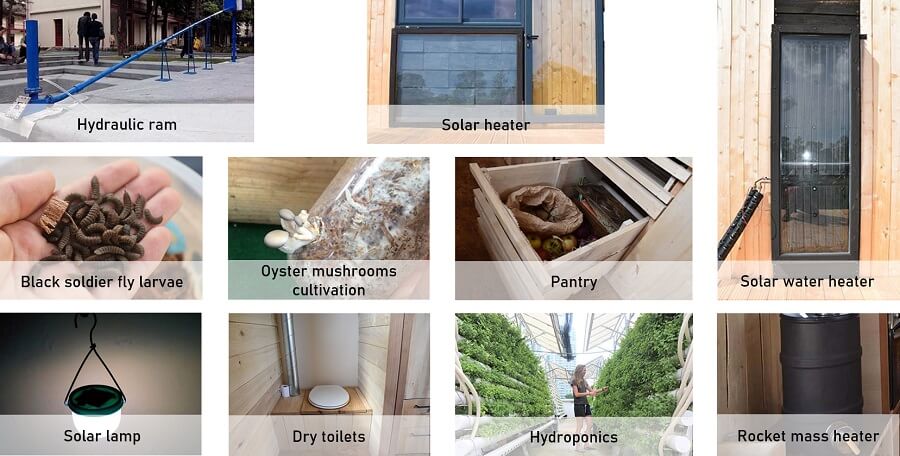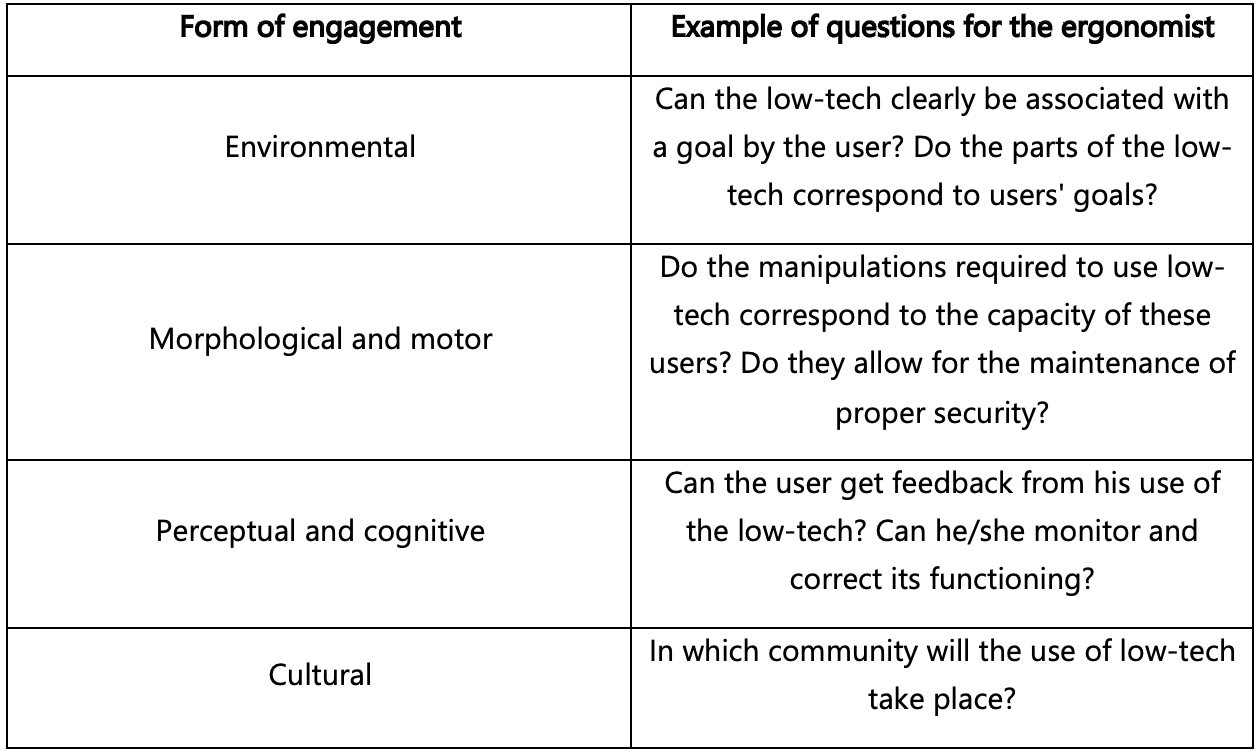How low-techs challenge ergonomics ?
Publication date : April 21, 2021
Authors : Clément Colin et Antoine Martin
The Low-tech Lab regularly gives the floor to experts. Today, on the occasion of the release of the Ergonomics and Low-tech study, Clément Colin and Antoine Martin have signed the article you are about to discover.
1. Introduction #
Ergonomics (or human factors) is the discipline that aims at understanding the interactions between humans and artefacts[1] with the goal of improving human well-being and the performance of the human-artefact[2] system.
Ergonomics has largely developed with industrialization and the concern to produce machines adapted to the work situations of the humans who use them. Since the 1970s, these machines have become digital machines, thus ergonomics has been increasingly devoted to “high-tech” products and services. Industry 4.0, remote work and autonomous vehicles are some of the most prominent topics within the community today. Logically, many of the theories and tools of ergonomics have been developed for digital interfaces (e.g. Bastien & Scapin’s or Nielsen’s usability heuristics).
Although a minority, work on low-tech tools exists within ergonomics even if it does not bear this name. For example, Rudolph Drillis has collected design standards from popular culture that are applicable to what we would now call “low-tech” tools. Unfortunately, these works focus mainly on biomechanical and anthropometric aspects (minimization of pain-causing gestures, etc.) and less on the overall experience of using a low-tech tool. For example, they do not propose recommendations to (among other things) include hedonic aspects or an empowerment potential in a low-tech tool, yet these concerns are central to the modern low-tech approach.
Are contemporary ergonomics ill-equipped to accompany the development of low-techs?
This commentary first presents a study conducted by questionnaire with 400 people, which aimed at evaluating 10 low-techs (experimented or catalogued by the Low-tech Lab). Secondly, it presents the reflections that emerged from this study and that question ergonomics in the light of the low-tech approach: i) the need for a critical theory of needs within ergonomics, ii) the relevance of developing a method that allows for a behavioural assessment that is complementary to “classic” life-cycle assessments methods, and iii) the importance of updating our knowledge of physical tools. We hope that these will be interesting avenues of research for the ergonomics community and beyond.
2. Presentation of our study on 10 low-techs #
The study took the form of a questionnaire distributed to 400 people in the summer of 2020. The goal was to collect their representations on the low-tech approach and to measure their attitudes towards 10 low-techs (Rocket mass heater, Pantry, Solar heater, Oyster mushrooms cultivation, Hydraulic ram, Black soldier fly larvae, Solar water heater, Dry toilets, Hydroponics, Solar lamp; see image below). Before the pandemic, the study was supposed to take place in the physical presence of said low-techs in trade shows, this was not possible but remains an ideal for a future study.
The idea that sparked the study is a comment by one of the co-founders of the Low-tech Lab: “There is a lot of designing to be done to make these systems, which often use recycled materials, more aesthetic and (especially) more ergonomic”[4]. Another starting point was a first measurement of the ergonomic qualities of low-tech prototypes during a recent experimentation on low-tech housing.[5]

The overall results of the study are a visualization of the structure of the respondents’ representations on low-techs, a ranking of the 10 low-techs by intention of use, requirements in terms of mode of access, and a categorization of the reported problems (across all 10 low-techs). Finally, the study explored the perceived user experience of each low-tech. These results are summarized in the table below and detailed (in French) in the report available here [ici].
Main results #
Structure of the representations on low-techs
- The study collected, in the form of short texts, the respondents’ opinions on the low-tech approach. A statistical analysis of these texts allowed us to categorize their discourse into 3 themes: the stakes of low-tech (technical and societal transition), the conditions of the transition to the age of low-techs (accessibility, implementation at the individual level, psychological aspects) and the technologies to be abandoned/adopted.
- These topics can be used to structure the communications of low-tech associations or companies in accordance with important themes for the public.
Ranking of the 10 low-techs by intention of use
- The direct measurement of the intention of use of the 10 low-techs allows to establish 3 groups. Low-techs with a high intention of use (solar water heater, dry toilets, pantry). Low-techs with a medium intention of use (solar heating, rocket mass heater, solar lamp, oyster mushrooms cultivation). Low-techs with a low intention of use (hydroponics, hydraulic ram, black soldier fly larvae).
- These results give a first idea of which technologies are ready to be disseminated and which require either improvements or a more specific target.
Requirements in terms of access modes
- The access modes to low-techs can be categorized in 3 groups based on the responses collected: self-directed access, access through purchase, and access through direct learning.
- These results allow to visualize and quantify 3 types of access modes that associations and companies could offer.
Most frequent problems across all 10 low-techs
- The study collected 692 problems across all low-techs. They were classified in 15 categories: compatibility problems (171), information/knowledge/skills problems (98), missing functionality problems (74), manufacturing/installation problems (57), performance problems (55), usability problems (40), redundancy problems (34), safety/health problems (31), maintenance/servicing problems (25), hedonic problems (23), compatibility with values problems (22), utility problems (21), aesthetic problems (19), environmental impact problems (15), social problems (7).
- These categories could become points of attention for designers of low-techs. They can be used as a starting point for questionnaires, user testing, activity and task analyses etc.
Exploration of user experience dimensions for each low-tech
- We collected respondents’ perception of 4 user experience dimensions (usefulness, usability, hedonism, social aspect) for each of the 10 low-techs.
- These results allow us to evaluate each low-tech in details and to identify specific areas for improvement.
3. Towards a critical theory of needs : designing for authentic needs #
The term “need” is everywhere in ergonomics. Indeed, the users’ needs determine their activity and are therefore the starting point of the ergonomic approach. The primary meaning of the word is that of a specification (“requirement”) implying a design imperative. If the requirements collected during the “user research” phase are sometimes criticized or put aside, it is mainly for feasibility reasons (budgetary, temporal, strategic) that are external to the ergonomist. Indeed, the theories used in ergonomics do not offer a critical perspective on the notion of “need” which would allow us to go further in putting them into perspective.
A need can be defined as “a configuration of psychological and physical characteristics that is felt as a lack or a tension”[6] . Needs motivate human activity[7] and their expression depends on the context in which they are expressed (place, history etc.).
To meet the needs of users, the ergonomist classically acts on the characteristics of the artefact (e.g., position of the buttons) to ensure a good quality of interaction (usefulness, accessibility and usability) and a pleasure of use.
The low-tech approach wants to target “essential needs” in priority. How to define and recognize this class of needs? The ideal car, in the need expressed by the user or determined by the designer, is perhaps the one that brings no friction, no constraint, no effort. Should the hoverchairs imagined in the dystopian society of Wall-E[8] be design goals? The temptation to answer in the negative is all the greater if we take into account the “ratchet effect” and the “Collingridge dilemma”: it is difficult to predict the impact of a new technique before its massive deployment, which makes it difficult to control or redirect it afterwards. This difficulty is characteristic of our cumulative culture, which operates by trial and error and thus, makes planned sustainability difficult.
To help us distinguish between essential needs and others, the critical theory of needs (developed by the philosophers and sociologists Agnes Heller and André Gorz on the basis of the work of Marx) opposes “authentic”[9] needs to “artificial” needs :
- The first (authentic needs) are composed of absolute biological needs which are universal and “on which the survival of the organism depends : eating, drinking and protecting oneself from the cold, for example”[10]. Authentic needs can also be psychological. The psychologists Ryan & Deci distinguish three basic psychological needs that are universal, unfulfillable and non-hierarchical: autonomy, relationship with others and competence. Their satisfaction is necessary for well-being.
- Artificial needs, on the other hand, are alienating, i.e., they lead to a loss of autonomy or dispossess the human being of his or her life. They imply mass production (mass production, standardization, diversification and complexity) which destroys the human being and his or her environment[11].
It is up to the ergonomics or human factors specialist to seize this distinction to make a critical diagnosis and try to meet the authentic needs first. In practical terms, here are some concrete actions to implement :
- identify the authentic need behind the artificial need and make a priority to address it first, for example by recognizing and eliminating needs that will bring about only marginal comfort[12] ;
- do not determine new artificial needs via a technological solution ;
- be better at helping users in knowing and expressing their needs (a task that is among the most difficult for both the user and the designer[13]) ;
- make a priority to identify and design “desirable” activities (e.g., consuming less energy in winter) in order to make them simpler and more satisfying to carry out, and thus allow their dispersion in the general population ;
- in order to avoid the alienation of the user, use the recommendations of the philosopher Ivan Illich[14] on the characteristics of the fair tool (“it generates efficiency without degrading personal autonomy, it creates neither slaves nor masters, it widens the radius of personal action”) and those of the sociologist Razmig Keucheyan[15] for emancipated goods (they are robust/stable, dismountable/modular, interoperable, evolutive) ;
- include in our approaches the necessary negotiations between manufacturers and users so that they can determine together “acceptable” needs[16].
4. Towards “behavioural assessment” : designing for desirable uses #
Life-cycle assessments (or LCAs) are methods for measuring the environmental footprint of a product or service from its production to its end of life: extraction of raw materials, water, transportation, etc. However, LCAs forget one important variable. The environmental impact of a technical system depends strongly on the use that will be made of it. For example, in the building sector, experiments aimed at reducing energy consumption have taken place by focusing on the energy efficiency of buildings and equipment. Yet, the expected reductions in consumption have not been observed[17]. This discrepancy can be explained by the difference between the representation that the designers have of the inhabitants and the behaviour of inhabitants, which leads to a discrepancy between the intended use and the real use of the building and equipment[18], thus limiting its energy efficiency.
This example reveals that systems, however efficient they may be from an LCA point of view, are only really efficient if they generate sustainable behaviours. It is therefore essential to design the uses that accompany technical systems to ensure that they are desirable.
Currently, ergonomics proposes to analyse user behaviours and knowledge to ensure that they are taken into account at the design stage. Similarly, it sometimes studies behaviour during use, but is often limited to the analysis of errors and safety risks. The compliance of the generated behaviours with sustainability objectives is only very rarely studied. For example, the ergonomist does not observe whether new users of electric vehicles (EVs) behave in an energy-efficient manner or whether the purchase of an EV leads them to drive more often. Moreover, these “compliant” behaviours are not defined at the start of the project.
Given the strong emphasis on sustainability in the low-tech approach, adapted ergonomics should i) identify the actual behaviours generated by the low-tech object and ii) help to modify the object to reduce undesirable behaviours (e.g., early disposal, misuse) and facilitate desirable ones (e.g., repair, sharing knowledge).
The following is a proposed approach[19] that delineates this so-called “behavioural assessment” :
1 / Understand the context of use (existing infrastructure, internal and external factors driving the action).
2 / Define target behaviours when using a low-tech.
3 / Measure the actual usage behaviours of the low-tech.
4 / Compare target behaviours with actual behaviours.
5 / Modify the object if divergent behaviours appear :
5.a / Prevent undesirable behaviours :
5.a.i / Make a behaviour impossible (e.g., limit the heating capacity of a kettle to 80°C).
5.a.ii / Improve the user’s understanding of the behavioural problem (e.g. feedback).
5.b / Facilitate desirable behaviours :
5.b.i / Include in the design ways to limit or neutralize socio-cognitive biases. For example, we are subject to moral compensation bias: when a morally positive action (e.g., investing in energy efficient equipment) is used to legitimize a morally less positive action (e.g., no longer monitoring one’s energy consumption). This approach is opposed to the paternalistic logic used in marketing or behavioural economics (e.g., nudging) to induce behaviour and usage.
5.b.ii / Designing a positive user experience for the target uses.
This strategy has the advantage of putting the burden of user behaviour on the manufacturer of the object. It is the company that is mostly responsible for the generated behaviours and that must act on its technological proposal to limit the undesirable effects of its use.
5. Designing for less digital interactions #
Non-digital tools[20] represent an important part of low-tech objects (e.g., rocket mass heater). With them comes the reintroduction of less stereotyped manual interactions (making, handling and repairing). Ergonomics has taken off around digital tools, so the methods and models of ergonomics are often calibrated for them (e.g., usability criteria for interfaces). It is therefore important to reinvest the subject in a different light: from the perspective of ergonomics applied to low-techs.
Chris Baber[21] identifies 4 forms of engagement between humans and non-digital tools :
- environmental engagement (separate from environment/manufacture)
- morphological and motor engagement (manipulation of the tool with the body)
- perceptual and cognitive engagement (plan, monitor, feedback)
- cultural engagement (community, praxis, rules).
These four forms of engagement provide a framework for the ergonomist working to improve a low-tech product (see table below).

In 2020[22], French psychologists and ergonomists proposed a new field of cognitive science, “technition”, which could serve as a breeding ground for ergonomics adapted to low-techs. Their observation: there is a lack of work on the technical skills of humans (tool making, tool selection, tool use, etc.). What is the interest of this for low-techs? This new field supports the idea that tools such as low-techs are not simplistic: in cognitive terms, the technical skills required to make a tool go beyond “simple” manipulation or the use of low-level cognitive skills: imitation, creation, anticipation and problem-solving skills are also involved. It is up to ergonomics to take this work into account to design better low-techs.
Acknowledgments #
The authors thank Clément Chabot (for his support throughout the study and for his warm welcome to the Low-tech Lab), Solène de Jacquelot (for giving visibility to the results of the study) and Amandine Garnier (for sending out the questionnaire). We warmly thank Nada Negraoui for introducing us to the works of Razmig Keucheyan, André Gorz and Agnes Heller, that are cited in this article. Finally, we would like to thank the 400 people who responded to our questionnaire and thus made the study possible.
Bibliographie #
[1] Artefact is the general term for describing physical of digital objects designed by humans.
[2] For a more thorough definition see:
What Is Ergonomics? (2000). iea.cc/what-is-ergonomics/iea.cc/what-is-ergonomics
[3] Drillis, R. J. (1963). Folk Norms and Biomechanics. Human Factors, 5(5), 427‑441. doi.org/10.1177/doi.org/10.1177/001872086300500502
[4] Nahmias, M. (2019). Système D comme désirable. Socialter Hors-Série : L’Avenir Sera Low-Tech, 6, 39–41.
[5] L’Avenir Sera Low-Tech, 6, 39–41.
Lévêque, P.-A., & Chabot, C. (2020). Habitat low-tech. Low-tech Lab. lowtechlab.org/fr/le-low-tech-lab/les-actions/lowtechlab.org/fr/le-low-tech-lab/les-actions/habitat-low-tech
[6] Colin, C., Barcenilla, J., & Brangier, E. (2021). Besoin. In E. Brangier & G. Valléry (Éds.), Dictionnaire encyclopédique de l’ergonomie : 150 notions clés (Dunod).
[7] “The object of the activity is the motive that gives it a conscious and specific orientation, and behind which is necessarily a need or a desire that the activity must allow to reach”
Leontiev (1974) cited by Darses, F., Falzon, P., & Munduteguy, C. (2004). Paradigmes et modèles pour l’analyse cognitive des activités finalisées. In P. Falzon (Éd.), Ergonomie (p. 191‑231). Presses Universitaires de France. cairn.info/ergonomie—9782130514046.htm
[8] Hoverchairs. (2010). In Pixar Wiki. pixar.fandom.com/wiki/Hoverchairs
[9] Aussi appelés « qualitatifs » ou « radicaux ».
[10] Voir page 32 : Keucheyan, R. (2019). Les besoins artificiels. La Découverte. editions-zones.fr/lyber
[11] Voir pages 111-112 : Keucheyan, R. (2019). Les besoins artificiels. La Découverte. editions-zones.fr/lyber
[12] In France, the term seems to have been used for the first time by Claire Richard while describing the “marginal comfort economy” (Claire Richard, L’ubérisation : peu de profits réels, sauf pour les plus riches, 2019). It has been expanded upon by a clothing brand, Loom (Renoncer au confort marginal : comment le coronavirus nous montre qu’on peut changer de modèle de consommation, 2020
[13] For example, page 9: “[…] people themselves are often unaware of their true needs, even unaware of the difficulties they are encountering. Getting the specification of the thing to be defined is one of the most difficult parts of the design […]”.
Norman, D. (2013). The design of everyday things. Basic Books.
See also page 76:
Martin, A. (2021). Méthodes d’ergonomie prospective pour l’exploration des besoins futurs. Université de Lorraine.
[14] See page 27 : Illich, I. (1973). La convivialité. Éditions du Seuil.
[15] Voir pages 137-141 : Keucheyan, R. (2019). Les besoins artificiels. La Découverte. editions-zones.fr/lyber
[16] Voir pages 188-192 : Keucheyan, R. (2019). Les besoins artificiels. La Découverte. editions-zones.fr/lyber
[17] Blaise, G., & Glachant, M. (2019). Quel est l’impact des travaux de rénovation énergétique des logements sur la consommation d’énergie ? La Revue de l’Énergie, 646, 46‑60.
Sidler, O. (s. d.). De la conception à la mesure, comment expliquer les écarts ? batiment-energie.org/doc/01-ENERTECH.pdf
[18] Zélem, M.-C., Gournet, R., & Beslay, C. (2013). Pas de « smart cities » sans « smart habitants ». URBIA - Les cahiers du développement urbain durable, 15, 45‑60.
[19] Adapted from : Lilley, D., & Wilson, G. T. (2017). Design for sustainable behaviour. In J. Chapman (Éd.), Routledge Handbook of Sustainable Product Design (p. 127‑144). Routledge. taylorfrancis.com/books/e/9781315693309
[20] Defined as a “physical object that is manipulated by users in such a manner as to both affect change in some aspect of the environment and to represent an extension of the users themselves. The manipulation is directed towards a specific goal or purpose, and the associated activity requires a degree of control and coordination.” See pages 8-9:
Baber, C. (2003). Cognition and tool use: Forms of engagement in human and animal use of tools. CRC Press. doi.org/10.1037/a0023566
[21] Baber, C. (2003). Cognition and tool use: Forms of engagement in human and animal use of tools. CRC Press.
[22] Osiurak, F., Lesourd, M., Navarro, J., & Reynaud, E. (2020). Technition: When tools come out of the closet. Perspectives on Psychological Science, 15(4), 880‑897. doi.org/10.1177/1745691620902145



